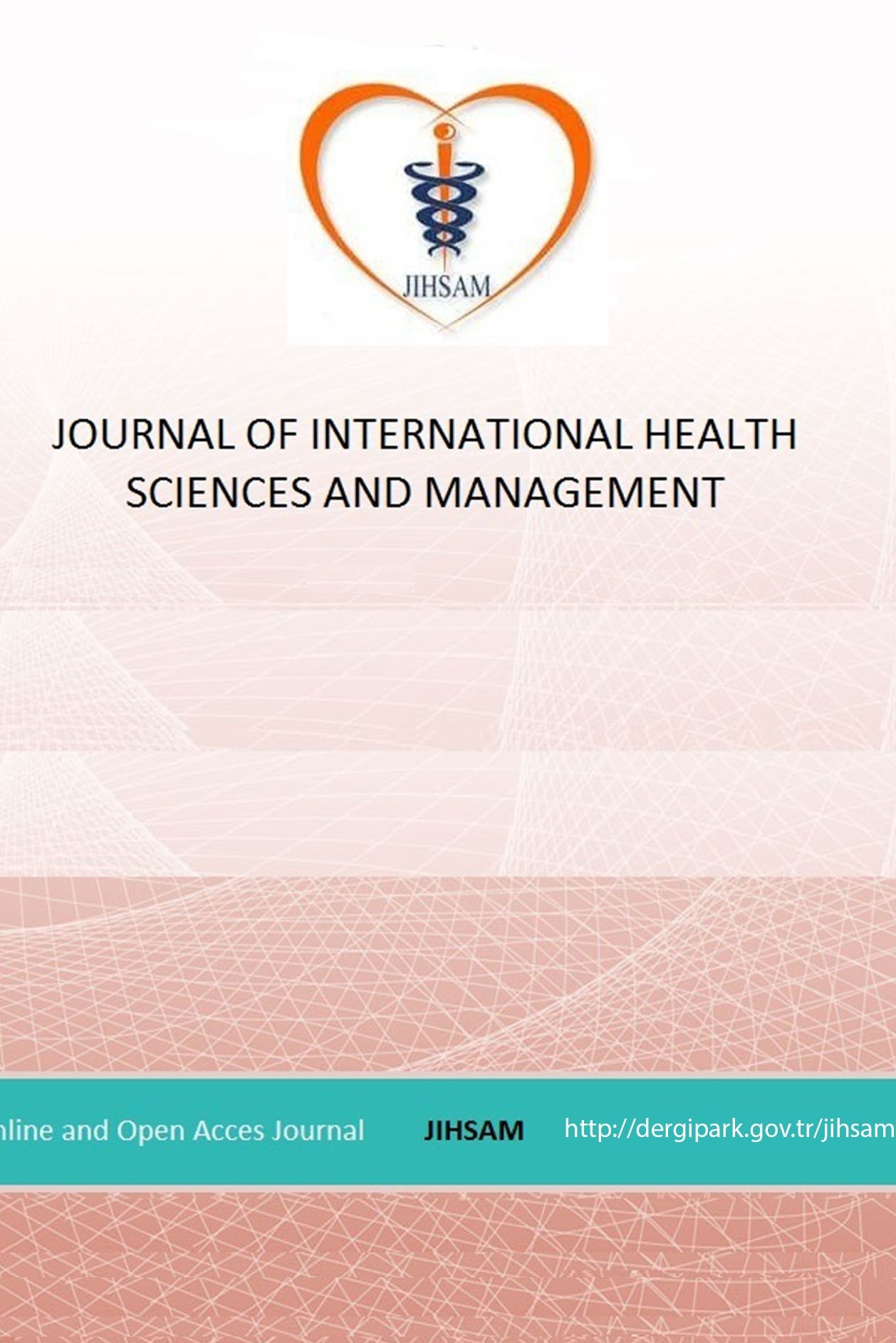The Perceptions of Older Turkish Immigrants of the Healthcare Professionals in their Home and Host Countries
The Perceptions of Older Turkish Immigrants of the Healthcare Professionals in their Home and Host Countries
health professional, older immigrant,
___
- Campbell C,, Mclean C, (2002). Ethnic identities, social capital and health inequalities: factors shaping American-Craibbean participation in local community networks in the UK. Sos Sci Med, 55, 643-657.
- Davies A.A., Basten A., Frattini C. (2009). Migration: a social determinent of the health of migrants, Eurohealth, IOM.
- Erol, H., Özdemir A. (2014). Türkiye’de Sağlık Reformları ve sağlık harcamalarının değerlendirilmesi, Sosyal Güvenlik Dergisi, 4(1), 9-34.
- Ferraro KF.,Shippee T. (2009). Aging and cumulative inequality: How Does Inequality Get Under the Skin? The Gerontologist, 49 (3), 333–343.
- Ferreira, M.,& Kowal, P. (2006). A minimum data set on ageing and older persons in Sub-Saharan Africa: process and outcome. African Population Studies, 21(1), 19-36.
- Fokkema T.,Naderi R. (2013). Differences in late-life loneliness: a comparison between Turkish and native-born older adults in Germany. Europian Journal of Ageing, 10, 289-300.
- Glesne C. (2012). Becoming qualitative researchers: An Introduction, 4th edn. Boston: Pearson.
- Glinos I. A., Baeten R., Helble, M., Maarse, H. (2010). A typology of cross-border patient mobility. Health & place, 16(6), 1145-1155, doi:10.1016/j.healthplace.2010.08.001.
- Horton S., Cole S. (2011). Medical returns: seeking health care in Mexico.Soc Sci Med, 72(11),1846-52, doi: 10.1016/j.socscimed.2011.03.035. Epub 2011 Apr 13.Lai D., Chau S. (2007). Predictors of health service barriers for older Chinese immigrants in Canada. Health Soc Work, 32 (1), 57-65.
- Leduc N., Proulx M. (2004). Patterns of health services utilization by recent immigrants. Journal of Immigrant Health, 6 (1), 15-27, doi: 10.1023/B:JOIH.0000014639.49245.cc.
- Lee J.Y., Robin A.K., Friesen W. (2010). Seeking affective health care: Korean immigrants’ use of homeland medical services. Health Place, 16,108-115, doi: 10.1016/j.healthplace.2009.09.003.
- Lokdam N, Kristiansen M, Handlos LN, Norredam M. (2016). Use of healthcare services in the region of origin among patients with an immigrant background in Denmark: a qualitative study of the motives. BMC Health Services Research,doi: 10.1186/s12913-016-1346-1 16-99.
- Main I. (2014). Medical Travels of Polish Female Migrants in Europe. Sociologicky Casopis, 50(6), 897-918, doi: http://dx.doi.org/10.13060/00380288.2014.50.6.147.
- Martin S.S. (2009). Healthcre-seeking behaviours of older Iranian immigrants: health perceptions and definitions. J Evid Based Soc Work, 6,58-78, doi: 10.1080/15433710802633452.
- McDonald J.T., Kennedy S. (2004). Insights into the ‘healthy immigrant effect’: health status and health service use of immigrants to Canada. Sos Sci Med, 59(8),1613-1627, doi:10.1016/j.socscimed.2004.02.004.
- Migge B., Gilmartin M. (2011). Migrants and healthcare: investigating patient mobility among migrants in Ireland. Health Place, 17(5), 1144-1149, doi: 10.1016/j.healthplace.2011.05.002.
- Nazroo J., Jackson J., Karlsen S., Torres M. (2008). The black diaspora and health inequalities in the US and England: does where you go and how get there make a difference? In W. Ahmad, & H. Bradby (eds) Ethnicity, health and health care - Understanding diversity, tackling disadvantage (pp. 16-34), Oxford: Blackwell.
- Österle A, Johnson T., Delgado J. (2013). A Unifying Framework Of The Demand ForTransnational Medical Travel, The International Mobility of Patients, 43(3): 415-436 https://doi.org/10.2190/HS.43.3.c.
- Özdemir, O. , Ocaktan, E., Akdur, R. (2014). Sağlık Reformu Sürecinde Türkiye ve Avrupa’da Birinci Basamak Sağlık Hizmetlerinin Değerlendirilmesi. Ankara Üniversitesi Tıp Fakültesi Mecmuası, 56(04), 207-216.
- Papadopoulos S. L., Lay M., Gebrehiwot A. (2007). Ethiopian refugees in the UK- Migration, adaptation and settlement experiences and their relevance to health. Ethn Health, 9 (1), 55-73, doi:10.1080/1355785042000202745.
- Perloff R.M., Bonder B., Ray G.B., Ray E.B., Siminoff L.A. (2006). Doctor-patient communication cultural competence and minority health -Theoretical and empirical perspectives. American Behavioral Scientist, 49 (6), 835-852, doi: 10.1177/0002764205283804852.
- Poortinga W. (2006). Social capital: an individual or collective resource for health. Sos Sci Med, 62, 292-302, doi:10.1016/j.socscimed.2005.06.008.
- Razum O., Sahin-Hodoglugil N.N., Polit K. (2005). Health, wealth or family ties? Why Turkish work migrants return from Germany. Journal of Ethnic and Migration Studies, 31(4), 719-739, doi: 10.1080/1369183050109894.
- Saygın Avşar T., Erdem R., Akkaş E. (2017). Evaluation of the healthcare transformation programme in Turkey as a strategy for better health. Journal of International Health Sciences and Management, 3(1), 11-19.
- Schenk L. (2008). “Gesundheit und Krankheit älterer und alter Migranten”, in A. Kuhlmey and D. Schaeffer (Eds.), Alter,Gesundheit und Krankheit (156-174), Huber.
- Scheppers E., Dongen E.V., Dekker J., Geertzen J., Dekker J. (2006). Potential barriers to the use of health services among ethnic minorities: a review. Fam Pract, 23(3), 325-348, doi:10.1093/fampra/cmi113.
- Steinbach A. (2017). Older Migrants in Germany. The Journal of Population Ageing, doi: 10.1007/s12062-017-9183-5.
- Şekercan A., Lamkaddem M., Snijder M.B., Peters R.J., Essink-Bot M.L. (2015). Healthcare consumption by ethnic minority people in their country of origin.Eur J Public Health, 25(3),384-390, doi:10.1093/eurpub/cku205.
- Topal K., Eser E., Sanberk I., Bayliss E.,Saatci E. (2012). Challenges in access to health services and its impact on quality of life: a randomised population-based survey within Turkish speaking immigrants in London. Health Qual Life Outcomes, 10,1-11, doi: 10.1186/1477-7525-10-11.
- Van de Ven A.H. (2014). What matters most to patients? Participative provider care and staff courtesy. Patient Experience Journal, 1(1), 131-139.
- Yıldız, Z.and Erdoğmuş, Ş. (2004). Measuring patient satisfaction of the quality of health care: A study of hospitals in Turkey. Journal of Medical Systems, 28( 6):581-589.
- Warne M., Friendich K., Kellaher L., Torres S. (2004). The diversity and welfare of older migrants in Europe. Ageing&Society, 24, 307-326, doi: 10.1017/S0144686X04002296.
- Wengler, A. (2011). The health status of first-and second-generation Turkish immigrants in Germany. International journal of Public Health, 56(5), 493-501.
- Yayın Aralığı: Yılda 2 Sayı
- Başlangıç: 2015
- Yayıncı: Sedat BOSTAN
Nilüfer KORKMAZ YAYLAGÜL, Suzan YAZICI, Ahmet Melik BAŞ, Yusuf Cem YERLİ
PROGRESS OF MOBILE HEALTH: USES AND BENEFITS
THE EFFECTS OF INTERNAL MARKETING ACTIVITIES ON ORGANIZATIONAL CITIZENSHIP BEHAVIOR
THE RELATIONSHIP BETWEEN CYBER LOAFİNG AND JOB SATISFACTION IN HEALTHCARE EMPLOYEE
Yunus Emre ÖZTÜRK, Hilal AKMAN DÖMBEKCİ, Müjdat YEŞİLDAL
